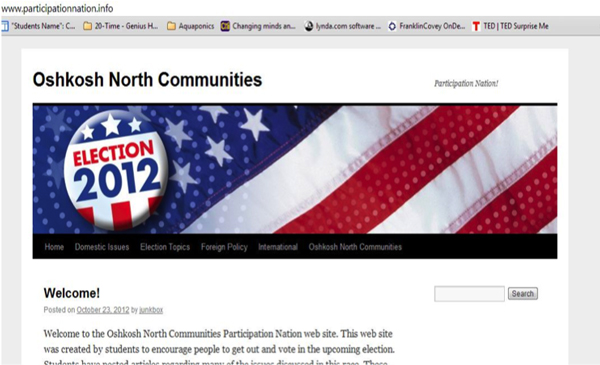My friend Oliver Schinkten knows 150 awesome human beings. They’re students in his Communities and leadership classrooms at Oshkosh North High School, and they routinely do amazing things.
Last year, each student in Communities found and interviewed a local veteran of World War II, the Vietnam War, or the Korean War. They prepared questions, conducted and recorded hour-long interviews, edited them into stories, and created keepsake DVDs for the veterans and their families. The students then planned and ran an event celebrating the service of these people and presenting them with the DVDs. Afterward, many families contacted Oliver to tell them how moving and powerful the experience was, and how the DVD was a priceless heirloom they would pass down for generations.
Pretty awesome stuff for high schoolers.
Or how about the hydroponics lab that the students are building? It isn’t just a 48-foot long hoop house that will raise fish and fresh vegetables around the year to be used in the cafeteria and sold locally. It’s also a STEM Learning Center, creating a living lab for students from Oshkosh North and offering educational tours to school groups from around the area.

And it’s being funded, designed, built, and staffed by high school students.
People often assume that Oliver is teaching a gifted class, but he has public-school students from all different backgrounds, with a variety of historic levels of achievement. He says that the difference is authenticity. When students realize that what they are doing matters and is real, they engage, and the results speak for themselves.

These students, who couldn’t even vote, appeared on local TV, radio, and street corners encouraging the rest of us to do so.
So, Oliver’s students are achieving spectacularly, but what else are they getting out of their experience? For one, they are learning content: the history of the conflicts in World War II, Korea, and Vietnam; the symbiosis between fish and plants within a closed ecosystem; the impact of media on election cycles. In addition, they are learning to think critically and creatively, to innovate and solve problems, to communicate and collaborate. They are learning all of this while connecting to and enriching their communities.
That’s perhaps the most amazing outcome of all. Students are learning compassion. After the powerful impact of numerous altruistic projects last year, this year’s students are eager to select more projects that make a difference. They want to do good.
Who woulda thunk you could teach compassion?
Oliver Schinkten woulda thunk. In fact, he’s beginning to describe the altruistic innovations of his students as “Compassion-Based Learning.”
Some people fear what will happen when the next generation takes over. I don’t. I’ve seen what the next generation is capable of, and it’s pretty amazing stuff.